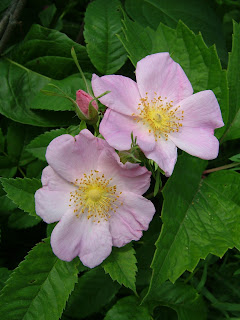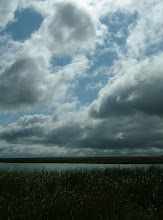
Yes, it was an annoying part of college exams, but it is a valid way of understanding things more deeply. Compare and contrast. When you are out for a walk, stop and look at what is to your right for a moment. Then turn to look at what is to the left. Look from one side to the other to find things that are the same on both sides. Then find things that are different. Go back to looking for same things, then unique things. The more times you alternate from one side to the other, the more details about the scene you will absorb. The more deeply you will understand the scene. You might think that you are in the midst of a pretty uniform woodland area,  but maybe one side is drier than the other, one side might get more light, the path might restrict spread of plants, so that there really are observable differences. Or you might be in a place where there is a stream on one side and prairie on the other, very different things, but there will still be similarities to be found in those apparently diverse scenes. Try to find differences in two plants of the same species. Try to find similarities in two different species of plants. In a tree and a flowering plant. In a plant and a stone. Comparing and contrasting each to the other helps to expose relationships and dependencies. You can also tease out details by comparing and contrasting the experience via different senses.
but maybe one side is drier than the other, one side might get more light, the path might restrict spread of plants, so that there really are observable differences. Or you might be in a place where there is a stream on one side and prairie on the other, very different things, but there will still be similarities to be found in those apparently diverse scenes. Try to find differences in two plants of the same species. Try to find similarities in two different species of plants. In a tree and a flowering plant. In a plant and a stone. Comparing and contrasting each to the other helps to expose relationships and dependencies. You can also tease out details by comparing and contrasting the experience via different senses.  Listen for a while and then look for a while and pay attention to what things you could detect with both senses and what things you could detect with one and not the other. Compare and contrast over time. Observe a scene in as much detail as you can, then take a nap there, and wake up to see what has changed. And make note of your mood at the beginning of your walk and compare and contrast that to your mood at the end of your walk!
Listen for a while and then look for a while and pay attention to what things you could detect with both senses and what things you could detect with one and not the other. Compare and contrast over time. Observe a scene in as much detail as you can, then take a nap there, and wake up to see what has changed. And make note of your mood at the beginning of your walk and compare and contrast that to your mood at the end of your walk!
 but maybe one side is drier than the other, one side might get more light, the path might restrict spread of plants, so that there really are observable differences. Or you might be in a place where there is a stream on one side and prairie on the other, very different things, but there will still be similarities to be found in those apparently diverse scenes. Try to find differences in two plants of the same species. Try to find similarities in two different species of plants. In a tree and a flowering plant. In a plant and a stone. Comparing and contrasting each to the other helps to expose relationships and dependencies. You can also tease out details by comparing and contrasting the experience via different senses.
but maybe one side is drier than the other, one side might get more light, the path might restrict spread of plants, so that there really are observable differences. Or you might be in a place where there is a stream on one side and prairie on the other, very different things, but there will still be similarities to be found in those apparently diverse scenes. Try to find differences in two plants of the same species. Try to find similarities in two different species of plants. In a tree and a flowering plant. In a plant and a stone. Comparing and contrasting each to the other helps to expose relationships and dependencies. You can also tease out details by comparing and contrasting the experience via different senses.  Listen for a while and then look for a while and pay attention to what things you could detect with both senses and what things you could detect with one and not the other. Compare and contrast over time. Observe a scene in as much detail as you can, then take a nap there, and wake up to see what has changed. And make note of your mood at the beginning of your walk and compare and contrast that to your mood at the end of your walk!
Listen for a while and then look for a while and pay attention to what things you could detect with both senses and what things you could detect with one and not the other. Compare and contrast over time. Observe a scene in as much detail as you can, then take a nap there, and wake up to see what has changed. And make note of your mood at the beginning of your walk and compare and contrast that to your mood at the end of your walk!
No comments:
Post a Comment